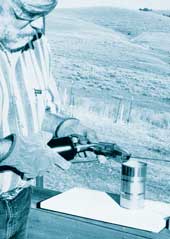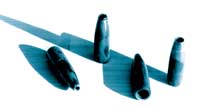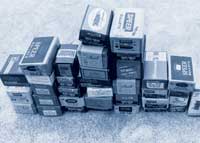What is your bullet's jacket thickness?
by Thomas Tabor
Most serious hunters are concerned how their bullet will perform when encountering an animal's tissue. Hunters who go after vermin usually prefer to shoot fragile bullets because of the amount of devastation these thin-skinned projectiles administer. Hunters who are attempting to save the pelts for either their own personal use or for market may have an opposite view. They usually like their bullets to be tough skinned in order to do as little outside damage as possible.
 Hunters who shoot larger game for food also have an interest in jacket thickness, but with a marked, different objective. These hunters require a bullet that will hold together, penetrate deep, do extensive damage deep inside the animal's vitals yet not damage a significant amount of the meat. Certainly each of these shooters share an interest in their bullet's jacket material yet each possess a different desire on how their bullet should perform.
Hunters who shoot larger game for food also have an interest in jacket thickness, but with a marked, different objective. These hunters require a bullet that will hold together, penetrate deep, do extensive damage deep inside the animal's vitals yet not damage a significant amount of the meat. Certainly each of these shooters share an interest in their bullet's jacket material yet each possess a different desire on how their bullet should perform.
Bullet construction varies greatly between bullet manufacturers, bullet types and their intended purpose. While most manufacturers attempt to advise shooters on what their bullets are intended to be used on, some individuals prefer to dive into the subject just a bit further. For years shooters have attempted to slice and hack their bullets down the middle in order to have a better look at the internal construction. From personal experience, I can attest to the fact that this is not an easy task when attempting to use tools normally found around home. Lead is soft, causing most rotary-type cutting devices to blind. It is also difficult to hold the tiny projectile while this process takes place. More than one finger has gotten in the way of such acts resulting in both frustration and injuries.
There may be a better solution to getting a good look at the internal construction of a bullet's jacket. Lead melts at one of the lowest temperatures of any metal - at about 164ºC (327ºF). It is remarkably easy to heat a bullet to that low melting point with a small, cheaply priced, hand-held propane torch. You know the kind - the type that many people have lying around the house for soldering, thawing frozen water pipes and starting the barbie. While these torches do not usually have the capabilities of reaching the temperatures necessary to melt other forms of metal, like the copper jacket material, they do just fine on small pieces of lead. Once the lead has been extracted, it is considerably easier to observe and evaluate the jacket. Once you reach this point, the jacket thickness can be better evaluated and it can be weighed on any powder scale.
 I have found a pair of pliers or vice-grips
can be used to grip the bullet while the lead is melted. A small metal
pan or can may be necessary to catch the molten lead as it pours free
from the jacket. Simply start the torch and heat the bullet. Within moments
the lead is separated and drips into the can. One point of clarification
may be necessary at this point: of course we are talking about the bullet
projectile only. I would hope there is not anyone out there who would
foolishly try to melt out the core of a bullet that is loaded as a part
of a live round of ammunition, but who knows...stranger things have happened.
I have found a pair of pliers or vice-grips
can be used to grip the bullet while the lead is melted. A small metal
pan or can may be necessary to catch the molten lead as it pours free
from the jacket. Simply start the torch and heat the bullet. Within moments
the lead is separated and drips into the can. One point of clarification
may be necessary at this point: of course we are talking about the bullet
projectile only. I would hope there is not anyone out there who would
foolishly try to melt out the core of a bullet that is loaded as a part
of a live round of ammunition, but who knows...stranger things have happened.
Whenever handling lead, a few safety precautions should be followed. Gloves and safety glasses are called for, as is good ventilation. Lead contamination can enter your body through the pores of your skin, by breathing the vapours during the melting process or through ingestion. Lead is accumulative in the human system. This means lead continues to build up throughout the individual's lifetime and is not cast off like some of other forms of contaminants. After a significant level has accumulated, signs of lead poisoning begin to show. So, don't breathe the vapours. Do not get the lead on your hands and skin. Do not eat or drink around lead and, once you have completed the work, wash your hands thoroughly in hot soapy water.
As the lead melts it may be necessary to jar or shake the bullet slightly in order to dislodge the lead residue. Be careful however. Lead melted at 164ºC is a lot hotter than you would like to have spattered on your hide or in your eyes. It's extremely difficult to reload an eye so always wear a pair of safety glasses.
 The bullet will cool quite quickly but if
you are in a hurry you can speed up the process by submerging the bullet
in a small pan of water.
The bullet will cool quite quickly but if
you are in a hurry you can speed up the process by submerging the bullet
in a small pan of water.
In order for this process to work, the jacket must be open ended at one end or the other. If the bullet is one of the H-style, A-frame or partition style of bullets, the jacket will have to be open on both ends in order to pour the molten lead out. For full metal-jacketed bullets that have lead cores, it will be necessary to snip off the tip so the molten lead can exit the jacket enclosure.
As indicated earlier, some shooters like to weigh the jacket shell before the lead has been removed. This value can be recorded in order to compare other bullet types of the same weight. A powder scale will perform this task perfectly. To go one step further, you can cross-section the jacket material if you desire. I have found that a small Dremel motor-tool grinder equipped with a cut-off wheel works great for this purpose. Simply hold the jacket firmly with your vice-grips or pliers and make the slice wherever you prefer. After this has been accomplished you can use a micrometre to determine the exact thickness of the metal jacket material. You may find in some cases that the jacket thickness will vary from one point on the bullet to another. Some manufacturers produce jackets that are thicker at the base than at the point or front end of the bullet. This is in an attempt to control the bullet's expansion.
The more we know about the bullets we shoot and how they are constructed, the better shooters we will be. This is just one way to help shooters expand their knowledge and expertise.
